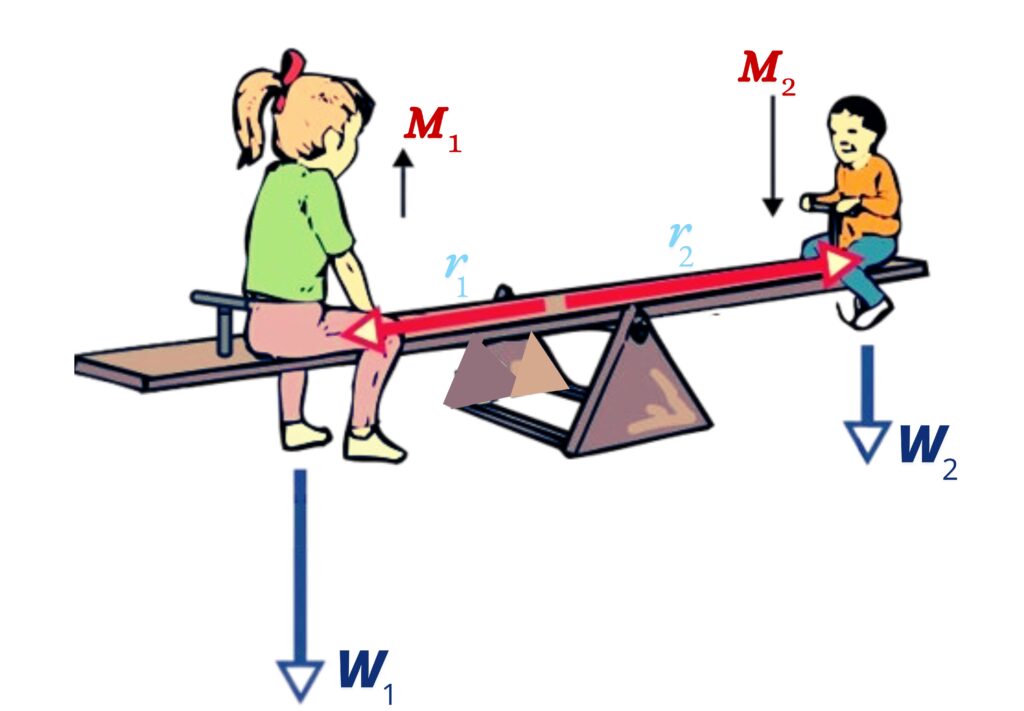Knowing what is moment in physics and how it is different from torque might not be of greater interest at the high school level but it sure is an important concept to know beyond that.
Table of Contents
Introduction
In physics, the moment is also known as the moment of force. It refers to the turning effect produced when a force acts at a distance from a pivot point. Moments are essential for understanding
- Stability
- Equilibrium
- and Rotation in
- structures
- mechanical systems
- and everyday activities
To understand what moment is, imagine a kid trying to open a heavy door. He pushed with all his strength, but the door would not budge. Unsatisfied, he applied even more force, yet it was futile.
Then, someone advised him to push the door from the edge rather than near the hinge. Following this advice, the door opened effortlessly. He realised that pushing closer to the hinge required significantly more effort, whereas pushing from the far edge made the door swing open with ease.
Why does this happen? This is where the concept of moments comes into play.
What is a Moment?
The moment is defined as,
“the measure of the tendency of a force or distribution of mass to produce a certain effect, such as rotation or bending, around a specific point or axis.”
Moments are often used to describe the influence of forces or masses on objects about a specific point or axis.
Key Terms of Moment
The key terms of the moment are similar to that of torque. To know more about it click here.
Key Properties of Moment
Moment and torque are the same in terms of their key properties. To know more about it click here.
Mathematical Formulation
Torque and moment also share the same mathematical formulation, however, in the case of moments, typically, forces and moment arms are perpendicular.
Mathematically, it is given as,
![]()
![]()
Here,
- M = moment
- r = position vector (moment arm–the distance from the axis or point of rotation)
- F = applied force
Difference between Moment and Torque
While the torque—the force that causes continuous rotation—and the moment work on the same principle, the latter generally deal with partial rotation in static systems.
The key difference is that moments typically result in less than 360-degree rotations, while torque usually involves continuous motion in a dynamic system.
The Principle of Moments
This principle states that,
“For an object to stay in balance, the total clockwise moments must equal the total counter-clockwise moments around a pivot.”
Mathematical Formulation
Mathematically, it is given by,
![]()
![]()
Moment, Principle of Moments and Equilibrium
To maintain balance, the total clockwise moments must be equal to the total counterclockwise moments. When this balance is achieved, the object remains in equilibrium and does not rotate. This principle ensures that structures and systems function without tipping or failing.
Example
Consider a seesaw with one kid on each end of the pivot.

For the balance condition, the moments created by their weights must be equal and opposite around the pivot. To achieve this, the lighter kid should sit farther from the pivot, and the heavier kid closer. This will create equal moments.
This principle is not limited to seesaws. It is fundamental to systems like bridges, machines, etc.
Why do Moments Matter? | Real-World Applications
Moments are everywhere around us. Here is how they shape the world around us.
- Tools and Levers: Wrenches, crowbars, and scissors use moments to amplify force, making tasks easier.
- Seesaws and Playgrounds: Moments allow for balance and fun by ensuring equal forces around a pivot.
- Everyday Actions: Opening doors, turning faucets, and using bicycles all rely on moments for smooth operation.
- Cranes and Machinery: Moments enable lifting and moving heavy loads efficiently by balancing forces around pivots.
- Bridges and Buildings: Moments ensure stability by balancing forces, preventing structures from tipping or collapsing under uneven loads.
Conclusion
Understanding the concept of moments is essential for analysing and solving real-world problems related to balance, stability, and rotation.
From seesaws in playgrounds to towering bridges and efficient machinery, moments govern the mechanics of countless systems and activities in our daily lives.
By grasping the principles behind moments and their applications, we gain insights into the forces at play around us and the engineering marvels that keep our world functional and safe.
Whether in designing structures, creating mechanical tools, or simply opening a door, the study of moments bridges theoretical physics with practical solutions. It showcases the profound impact of this concept on technology and life.
So, next time you push a door, adjust a lever or observe a construction project, remember that the invisible force at work is moments—shaping the world around us in ways we often take for granted.
Frequently Asked Questions (FAQs)
What is moment in physics?
A moment, also known as the moment of force, refers to the turning effect produced by a force acting at a distance from a pivot or axis of rotation. It measures how effectively a force can cause an object to rotate.
How is a moment different from torque?
Although similar, the main difference lies in their usage. Moments typically describe partial rotations or static systems, while torque is often associated with continuous rotational motion in dynamic systems.
What is the formula for calculating a moment?
The formula for a moment is:
![]()
The moment arm is the perpendicular distance from the pivot to the line of action of the force.
What is the principle of moments?
The principle of moments states that for an object to remain in equilibrium, the total clockwise moments must equal the total counterclockwise moments around a pivot point.
What are some real-world examples of moments?
Examples include opening a door, balancing a seesaw, using a wrench to tighten a bolt, and lifting heavy loads with a crane.
How do moments help in everyday tasks?
Moments allow us to use tools like levers, crowbars and wrenches to amplify force, making tasks like lifting, turning, or bending easier.
Why does pushing a door near its hinge make it harder to open?
Pushing near the hinge reduces the moment arm (distance from the pivot), requiring a greater force to produce the same turning effect.
How are moments used in engineering and construction?
Moments help ensure stability and balance in structures like bridges, buildings, and cranes by distributing forces evenly to prevent tipping or collapse.
What units are used to measure moments?
Moments are measured in Newton meters (Nm) in the SI system, where the force is in Newtons (N) and the distance (moment arm) is in meters (m).
What happens if the principle of moments is not followed in a system?
If the principle of moments is not satisfied, the system will lose balance, resulting in rotation, tipping, or failure of the structure or mechanism.
